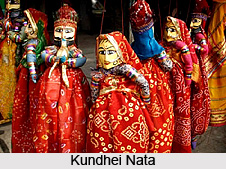 Kundhei Nata literally means doll dancing. It is the traditional form of puppet dance in Orissa. This form of dancing stages only two characters representing Lord Krishna and Radha. Jayadeva is credited with writing the famous play Gita Gobinda in the 12th century. It dealt with the themes related to Krishna-Radha that became very popular in Orissa for dramatic presentation. With time Lord Krishna became the ideal of worship and reached its zenith in the sixteenth century. In is during this time that themes centering on Krishna began influencing not only the theatre but also various branches of art and literature. During this time the popular forms of glove and string puppet traditions of Orissa began adopting different legends related to Krishna. During sixteenth century to nineteenth century many short poems, lyrics and long narrative verse were written that were based on Lord Krishna. These were later used in Puppet dancing.
Kundhei Nata literally means doll dancing. It is the traditional form of puppet dance in Orissa. This form of dancing stages only two characters representing Lord Krishna and Radha. Jayadeva is credited with writing the famous play Gita Gobinda in the 12th century. It dealt with the themes related to Krishna-Radha that became very popular in Orissa for dramatic presentation. With time Lord Krishna became the ideal of worship and reached its zenith in the sixteenth century. In is during this time that themes centering on Krishna began influencing not only the theatre but also various branches of art and literature. During this time the popular forms of glove and string puppet traditions of Orissa began adopting different legends related to Krishna. During sixteenth century to nineteenth century many short poems, lyrics and long narrative verse were written that were based on Lord Krishna. These were later used in Puppet dancing.
Performance of Kundhei Nata
Kundhei Nata is performed by two persons, the lead puppeteer and a drummer-cum-puppeteer. These performers do not enact on a stage rather they sit on a mat or on the ground and control the puppets in front of the audience. Sometimes even the drummer holds one of the two puppets and occasionally beats one side of the drum with the hand that holds the puppet. It appears as if the puppet is playing the drum. Singing is the main attraction of Kundhei Nata that inculcates humour. Kuratti, Kuravan (a tribal man), and Muttiyamma (grandmother) are the main characters of the play. In Kundhei Nata men enact the roles of women.
The instrumentalists and vocalists who were also a part of the play take their position in the rear. They are usually seen playing instruments like mridangam, drums and kaimani (small cymbals). They inaugurate the play by singing hymns in praise of Lord Ganesha and Goddess Saraswati. After their performances two Kurattis make their entrance and assume the roles of spouses of Lord Vishnu and Lord Shiva. They then enact various gestures of wordy fights through different forms of singing and dancing. During their arguments they find fault with each other`s husbands. In the concluding session a third Kuratti pretending to be Goddess Saraswati approaches for their rescue and then makes a comprises between the earlier two Kuratti. Later a Kuravan makes his entrance and displays many acrobatic acts that include rope dancing and musical plays. As a final act his old mother dances thus providing wholesome entertainment to the audience.




